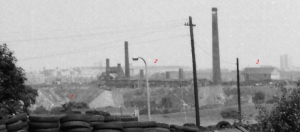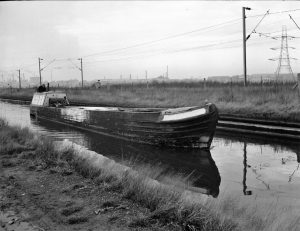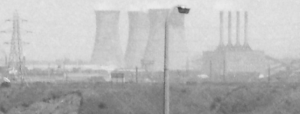One of the main focusses of this website was to assimilate all the recorded history of the site into one place. The canal traffic waste transportation of the white phosphorus contaminated material- i.e the stuff that poisoned the birds that was dumped into the lagoon, was one such jigsaw piece. It was previously stated in some books and by those at Trinity Street, that this traffic ended in 1969/70- but as evidenced by Roy Martin’s pictures and write up that is not the case at all. Another perspective of this traffic and the lagoon was written by Malcom Edge.
I am delighted that I have recently made contact with David Wilson, a local photographer who had the wisdom to capture some rare images of this traffic near its demise, and also he agreed to write a few words to accompany his pictures, which have previously been printed in some local history books. It is with great pleasure that he allowed me to reproduce them on this website. Hopefully they will leave with the other recollections, a timely reminder as to “what lies beneath rattlechain lagoon”- and it’s certainly not “toothpaste”!
I’ve archived a short version of David’s memory with the other recollections HERE, and it corroborates that in 1971, Albright and Wilson were still using Alfred Matty to transport their waste to rattlechain. I’d also like to thank David’s son Mark for his enthusiasm and help and also local historian Keith Hodgkins who archived some of David’s pictures.
I’ve also expanded some of the pictures to highlight some interesting observations.
By David Wilson, and forward by Mark Wilson
David Wilson is a canal enthusiast and amateur photographer. In the 1960s and 1970s he recorded much local commercial canal traffic, including some of the workings between Albright & Wilson and the Rattlechain Lagoon or Brickworks. He has had many of his photographs reproduced in several publications concerning local railway, road and canal traffic. He is local to the area, having grown up in Greets Green, West Bromwich. In addition, he has lived in Horseley Heath, Tipton, since 1966. He records his observations below.
“During the late 1960s & early 1970s, I witnessed the late stages of commercial canal traffic, in the West Midlands. The main regular traffic, was, gas oil from the various gas works (Walsall, Swan Village) to Oldbury. This was undertaken by “Clayton’s of Oldbury” in flush decked craft. I believe this traffic ceased around 1968.
The other regular traffic was phosphorous waste, taken from Albright & Wilson, in Oldbury, to a disposal site near Dudley Port. The boats used for this operation were owned by “Alfred Matty”, who were based at Coseley. The waste was in liquid form, and I seem to recall this waste had a distinctive odour, which reminded me of the smell at the swimming baths. The boats bore the greenish stains, and the cargo (to me) seemed hazardous. The phosphorous waste material, when at its destination, was to be then pumped into the marlhole.

1965, Matty boat descending the Brades Locks en- route to discharge hazardous cargo at rattlechain lagoon. Note the rattlechain brickworks buildings and stack still in evidence to the top left of the picture. Also the staining of chemicals on the boat as David describes. Picture Copyright David Wilson, reproduced with permission.

Enlargement showing three key structures. 1 the new brickworks pit that would become “the duport’s tip filled with waste from the Vono company and other illicit materials. 2 The rattlechain brickworks building still in situ. 3 a building that would be the last remnant of these works and is visible in a picture I have seen in 1973 when tipping at this site was in evidence. By then the brickworks themselves had vanished.
A brick structure housed the pumping equipment, pipes were connected from the boats, then it was discharged into the marlhole below. This marlhole was the one known locally as ‘Rattlechain Lagoon’. I also remember that the water in the marlhole was a duck egg green/blue colour. This, to my knowledge, was the only disposal site. “

1971, matty boat heading in the direction of Oldbury. Note the pumphouse building David refers to on the right of the picture on the towpath just partially in shot. Picture Copyright David Wilson, reproduced with permission.

One of David’s pictures dated 1971 showing a Matty boat heading back towards the direction of Oldbury. Had it just turned around at the Netherton branch or was it heading to Albright and Wilson from their Coseley base? Picture Copyright David Wilson, reproduced with permission.

1965 . A Matty boat called “the Maurine” towing another boat behind in the direction of Brades Locks. This area behind is Albright and Wilson’s Gower Tip. Copyright David Wilson , reproduced with permission.
It is very likely that the boat operator lost in the fumes of the boat is Enoch Clowes, who nearly died from passing out from the fumes when discharging the chemical waste from the Matty boat into Rattlechain- and left us the epitaph describing it as “a place in which nothing could live.”
One has to say that it is with great relief that phosphorus is no longer carried in this manner, and that lack of personal protective measures do not show that the cargo being carried was “safe”, more that the carriers and the company paying them were foolhardy.
Once again many thanks to David, Mark and Keith.



